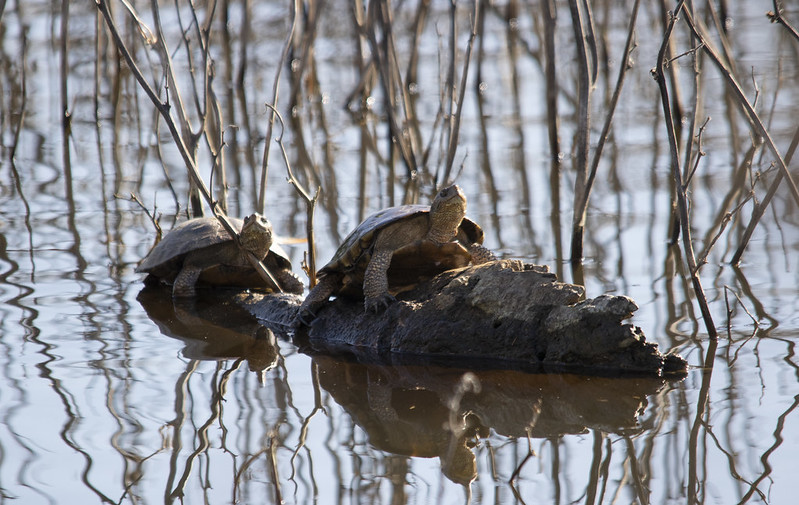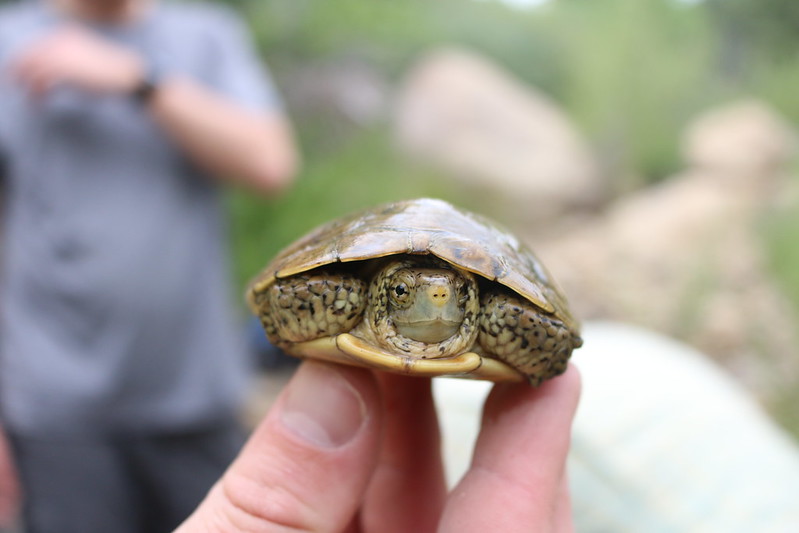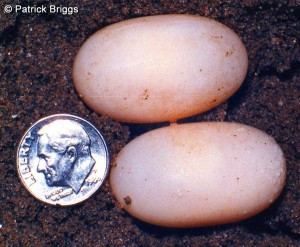Actinemys pallida
- Threatened (Proposed) – Endangered Species Act
- Species of Special Concern – California Department of Fish and Wildlife
- Sensitive Species – U.S. Forest Service
- Vulnerable (Actinemys marmorata) – IUCN Red List (1996)
- G3 Vulnerable (Actinemys marmorata) – NatureServe (2001)

The southwestern pond turtle is a species of western pond turtle that occurs from just south of San Francisco Bay to Baja California. Found throughout the Los Padres National Forest, these southwestern pond turtle populations are concentrated in Piru Creek, Sespe Creek, the Indian Creek/Mono Creek area, the Sisquoc River/Manzana Creek area, Alamo Creek, the Nacimiento River, and Arroyo Seco Creek. They also occur in most of the small coastal drainages of Santa Barbara and San Luis Obispo Counties.
Natural History
Southwestern pond turtles inhabit a wide variety of aquatic habitats from sea level to elevations of 6,500 feet. The turtles use their resident creeks, rivers, wetlands, lakes and ponds primarily for foraging for food, regulating their temperature, and for shelter to avoid predators. They use dry sunny basking sites for warming themselves such as rocks, logs, or thick floating vegetation. The turtles will engage in aggressive behaviors when competing for basking sites; they push and ram each other, threaten one another with open-mouthed gestures, and occasionally bite.
One report states that the southwestern pond turtle is “an omnivorous feeder, opportunistic predator, and occasional scavenger,” so in other words they eat just about anything! However, the majority of their diet consists of crustaceans, midges, dragonflies, beetles, stoneflies, and caddisflies in addition to the occasional detritus and plant matter they consume. They are often seen clinging to rocks in riffles, where they are typically feeding on chironomid (non-biting midge) larvae.

Along the central and south coast of California, southwestern pond turtles may be active throughout the year. When hibernating they will choose both aquatic and terrestrial areas, often in undercut areas along a stream bank or in upland burrows in leaf litter or soil (sometimes moving up to 1,600 feet from their usual aquatic homes).
Southwestern pond turtles do not start reproducing until 7-10 years of age. They will lay eggs in late spring to early summer, with their clutch size determined by age/size of the female and ranging from just one egg to 13. The juveniles hatch in late fall, but remain buried in the nest until the following March or April. Nest predation rates are high and total loss of a clutch of eggs is common. Large fish, bullfrogs, garter snakes, wading birds, and some mammals will prey on young turtles, but raccoons are the principal nest predators.
Threats
The primary reason for population declines in southwestern pond turtles is loss of suitable habitat exacerbated by intense nest predation. The availability of persistent, pooled water along low-elevation streams has been greatly reduced as the result of agricultural activities, urbanization, flood control, and water diversion projects. Raccoon densities are artificially high within a mile or two of housing areas, and illegal transport and release of trapped raccoons at Forest Service campsites maintains raccoon densities even in remote areas.
Other general threats include introduced non-native fish and bullfrogs that prey on young turtles, livestock and recreational activity that can destroy nesting habitat, and illegal collection of turtles in some easily accessible areas. Siltation (from intense grazing, mining, off-highway vehicles, or post-fire erosion) is also a threat as it can negatively affect good stream habitat.
Conservation
Southwestern pond turtles are found in our national forest’s waterways, which are some of the most ecologically sensitive and heavily impacted areas of the Los Padres. The 2005 Land Management Plan for the Los Padres National Forest includes special management requirements for protecting riparian areas. However, some of the activities that negatively impact turtle habitat occur with little oversight or enforcement by the agency. And even where proposed projects undergo environmental review and must adhere to the Land Management Plan, the proper implementation of these standards and guidelines needs to be strictly monitored to meet goals for protecting the species.
In 2012, the Center for Biological Diversity submitted a petition to list the Pacific or western pond turtle—before it was known to be two species (the northwestern and southwestern pond turtle)—as endangered under the Endangered Species Act. In 2023, the U.S. Fish & Wildlife Service proposed a “threatened” listing for both species of pond turtles, which may set the stage for long-term recovery of the species through critical habitat designation and more specific management requirements that agencies and other entities must follow when carrying out activities on federal public land.
ForestWatch will continue to closely monitor proposed projects in the Los Padres National Forest to ensure that southwestern pond turtles and their aquatic and upland habitats receive full protection, especially in light of their proposed “threatened” status.







